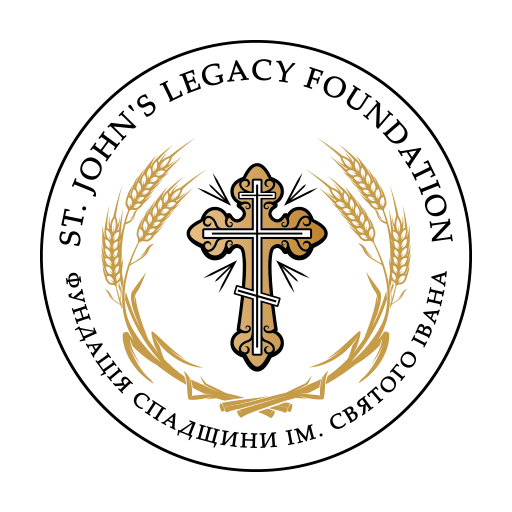Holy Ascension Ukrainian Orthodox Church – Radway (UOC)
The first stirrings of religious life in the Radway district began after the establishment of a Ukrainian National Home in 1917, as it provided a focus and forum for discussing community affairs. Catholic, Protestant, Orthodox, and Communist orientations all had their adherents among the Ukrainians who had begun settling in and around Radway from 1907 onward. Early visits by missionary priests with the Redemptorist Order only succeeded in alienating some of the Ukrainian faithful, as the “foreign” clerics often had a poor command of Ukrainian that was heavily accented and hard to understand, and they reminded many immigrants of the Polish clergy in Galicia. The situation was further aggravated after a Polish Catholic priest appeared and celebrated Mass in Latin for the Poles among Radway's inhabitants, in the process insulting the Ukrainians who were in attendance with some tactless remarks during his sermon.
Regardless, pro-Orthodox sentiment was already growing because of the recent establishment of the Ukrainian Greek Orthodox Church of Canada, which at the beginning of 1920 prompted sympathizers of the new formation to get the Radway burial ground named the "Ukrainian Greek Orthodox Cemetery".
The Orthodox cause received its first boost on 19 December 1920, when Reverend Ivan Kusey celebrated a St. Nicholas Day liturgy at the newly built Mazepa school. A large number of area residents attended the service, despite efforts by Father Philip Ruh (a French Oblate priest trained in Galicia for work among Ukrainian Canadians) to prevent it from taking place. Church activities subsequently became more formalized with the organization of a Brotherhood of Orthodox Ukrainians the following year. All of these developments stirred considerable tensions among Radway Ukrainians, since Belgian Redemptorist priests were also attempting to establish a Catholic church in the town. The appearance of a pro-Orthodox faction provoked controversy and heated debate, some of which was conducted on the pages of Ukrains'kyi holos.
Initially services were held at the homes of local supporters, the residence of Andrew Kowal being a frequent site for religious gatherings, including numerous weddings. Later, the Mazepa school was used for ritual observances. Priests would typically arrive by train and stay overnight with a member of the community. Construction of a sanctuary started in 1924, and although it was not yet finished, Archbishop Ioan Theodorovich was able to conduct a service there on September 21 of the same year while on a fall tour of Alberta congregations. (Another article says the service was held at Mazepa school). Theodorovich made a follow-up visitation on October 25, 1925, further inspiring the congregation in its efforts. The completed church was a tripartite structure, with a large central dome on an octagonal base.
In 1937 the congregation had a dozen members and celebrated nine liturgies in their church. In 1938, a manse was constructed for a resident priest, who served the Radway district.
A two-tiered iconostas, painted by Wadym Dobrolige (1913-1973) after his emigration to Canada, was installed in the church sometime in the 1950s or early 1960s.
The Cemetery
Situated at NW 29-58-20 W4, ½ mile south of the Village of Radway, it was established in 1927. The first burial was that of Mildred Pysmenny, who died in the spring of 1928.
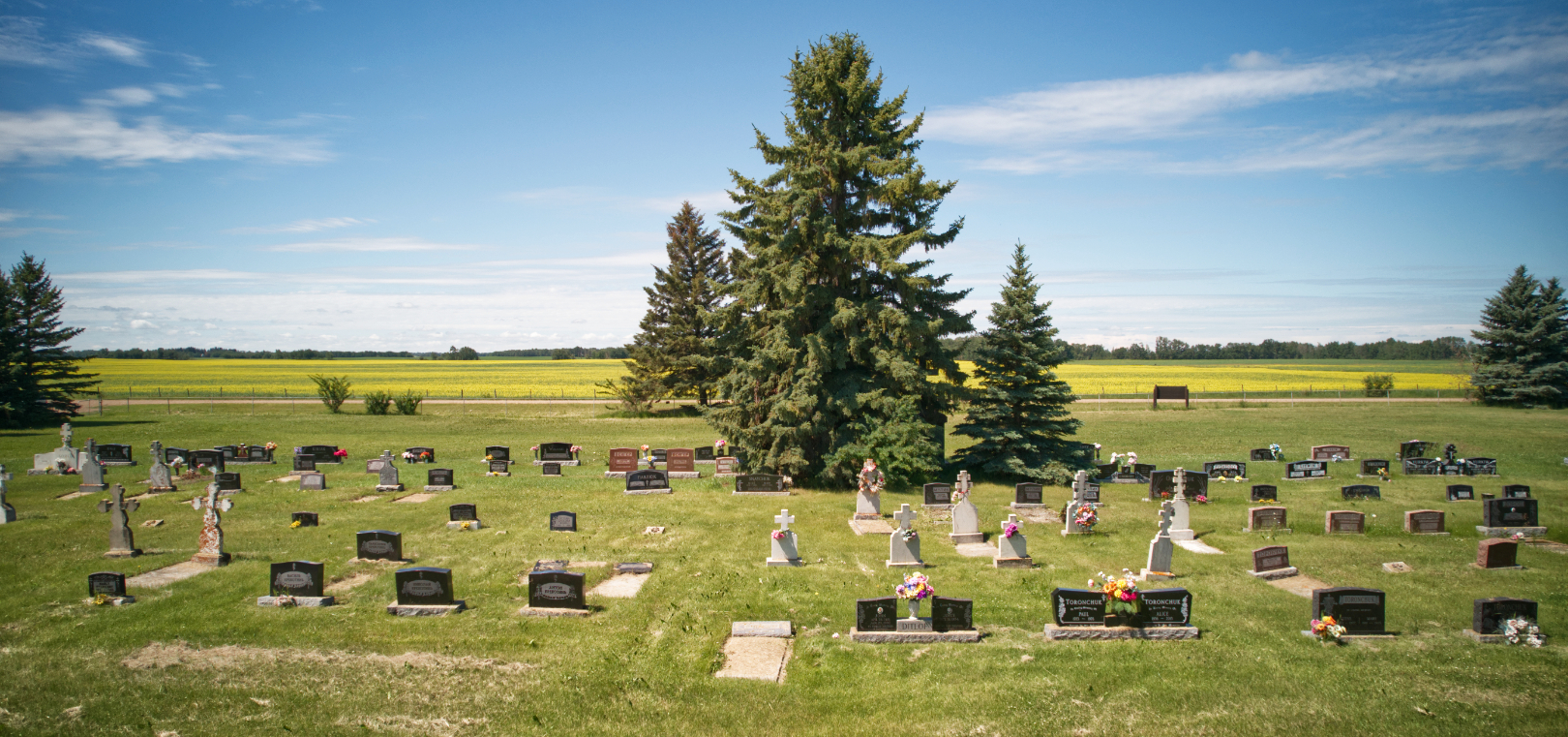
Play Memory Eternal Chant
GPS Co-ordinates: 54.058674, -112.948718
GPS Cemetery: 54.049941, -112.951009
Affiliation: Ukrainian Orthodox Church of Canada
Holy Ascension Ukrainian Orthodox Church – Radway, AB
Holy Ascension Ukrainian Orthodox Church – Pruth (UOC)
The founders of Holy Ascension Church were the pro-Ukrainian members of St. Dymytria Church when it was still under the jurisdiction of the Russian Orthodox Mission. As far back as 1920, Ukrainophile members of the Luzan Church had invited Father Dmytro Stratychuk to celebrate a liturgy in their sanctuary. However, the majority was opposed to having a priest from the newly organized Ukrainian Greek Orthodox Church, and thus a split developed within the community between the more nationally conscious Bukovynian farmers in the district and those who were influenced by the Russophile ideology promoted by the Russian Orthodox clergy.
On February 12, 1921, Rev. Lazar Gherman and Rev. I. Kusey celebrated a Divine Liturgy at the one-room Pruth schoolhouse after they were prevented from using St. Dymytria Church by pro-Russian Orthodox church members. Afterwards, Fr. Kusey appears to have held occasional services over the years at the homes of sympathizers of the UGOC, which continued to gain strength at the expense of the increasingly beleaguered Russian Orthodox Church. In 1930, Fr. Kusey’s successor in the area, Fr. I. Mayba, celebrated two Divine Liturgies in the Pruth district, indicating that the differences within the St. Dymytria congregation had not dissipated with the passing of time. Finally, these differences could no longer be contained, prompting forty-two inhabitants of the Pruth district—not all of whom were members of St. Dymytria church—to initiate a Ukrainian Orthodox congregation at a meeting held on February 13, 1931 at the Yuri Fedkovych National Home. Known locally as the Pruth Hall, the Narodny Dim was then used for church services until a proper place of worship could be built by the members of the new congregation.
Land for a church kitty-corner from the Pruth Hall was purchased soon after from William Prosteby with money obtained from donations, membership fees and loans. Steve and Mary Samoil, who had begun teaching at Pruth school in 1929 and were very active in the Fedkovych Society (where Steve was President, and Mary directed plays), figured prominently in the fundraising and membership drive. By August 1931 sufficient money had been raised to begin construction in the late summer, with volunteers working under the direction of Ivan Mnoholitny, who served as the head carpenter. Those who donated their labour were able to work off their membership, earning a credit of $1.50 for each day put in at the site. Construction was suspended at the end of November because of cold weather, but it resumed early the following year. Gradually, an impressive cruciform structure rose on the site with a large central dome, two small domes over the narthex and sanctuary, and similar-sized domes over twin towers flanking the façade. The first service was held in the church by Fr. D. Stratychuk in May 1932, while work was still proceeding on the interior. The sanctuary was then completed in June, and Archbishop Ioan Theodorovich consecrated the church at a Divine Liturgy celebrated on Ascension Day. The Second All-Alberta Convention of the Ukrainian Orthodox Church was also held on the same weekend, 6-7 August, drawing some 400 delegates and faithful to the gathering and celebration.
When it was being organized the congregation had just seven member families and eighteen sympathizers, though membership later grew to twenty-seven. In 1936, Rev. I. Hykawy reported that Pruth was one of the few better-off congregations in Depression-era Alberta. By 1940, however, the formal membership had been reduced to just eight families, as rural depopulation and the hardships of the Depression began to take a toll. This probably explains why the church interior was never elaborately decorated, the sanctuary simply being walled off and hung with icons to create an icon screen, and the walls and ceiling of the church being left largely unornamented, though stars for a time covered the ceiling (since painted over). To this day, the church does not have electrical power.
In 1952 the congregation reported that it had five services and six paid up members, whereas the following year it indicated that six services were held despite membership having declined to four. Nevertheless, the faithful persevered, and
In 1982 Pruth Church marked its fiftieth anniversary with a Divine Liturgy celebrated by Reverands S. Semotiuk and J. Puk. A plaque was blessed at the time honouring the founding members, two of whom were present – Mrs. Rachel Skakun and Mrs. William Prosteby. In 1990, the congregation was celebrating eight liturgies each year.
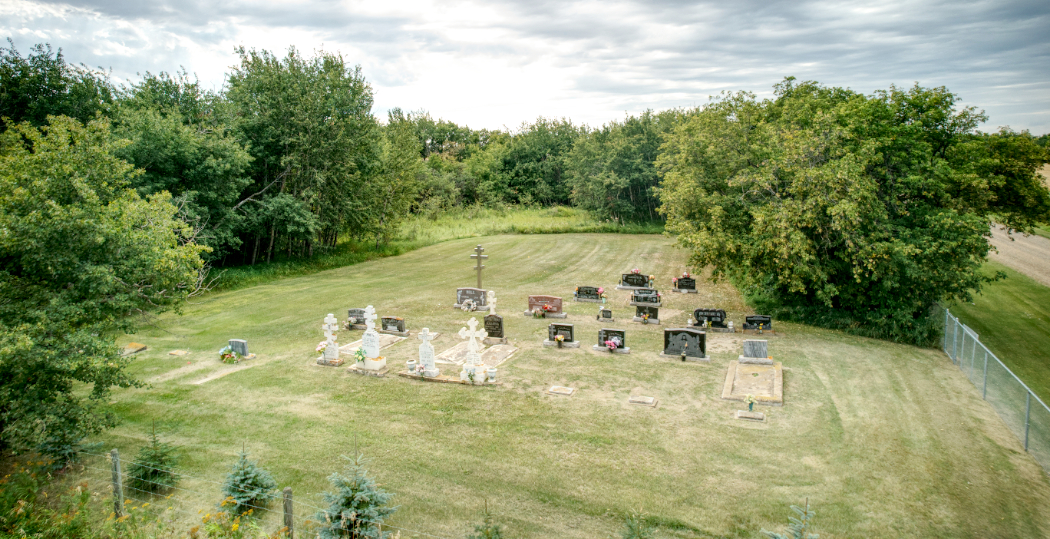

Play Memory Eternal Chant
GPS Co-ordinates: 53.744090, -112.133138
Cemetery GPS: 53.744106, -112.121212
Affiliation: Ukrainian Orthodox Church of Canada
Holy Ascension Ukrainian Orthodox Church – Pruth, AB
St. John the Baptist Ukrainian Orthodox Church – Peno (UOC)
The inception of a Ukrainian Orthodox congregation in Peno can be attributed to the disenchantment of some residence with the sectarian intolerance of Basilian priests serving the community from Mundare. By refusing to give absolution to anyone who confessed to reading Ukrains'kyi holos or Vistnyk, and by maintaining that it was better to stay home and play cards rather than attend a Russo or Ukrainian Orthodox Church, the Basilian fathers only managed to promote greater interest in the "forbidden fruit" that these rival denominations represented.
Until 1924 the Christian faithful of the Peno area were largely members of the local Catholic church. However, when a Ukrainian Orthodox priest visited nearby Bruderheim around this time, a small delegation of disaffected Peno farmers went to meet with him so as to learn more about the relatively new formation. Impressed with what they heard, they resolved to continue pursuing the possibility of joining the Ukrainian Greek Orthodox Church of Canada.
The first Ukrainian Orthodox service held at Peno took place in the home of Mykhailo and Teodosia Onyschuk in 1925, with Reverend D. Seneta officiating. As in the neighbouring settlement of Jaroslaw, where former Catholics were in the process of switching their allegiance to the UGOC, the people of Peno were especially moved to hear the liturgy sung in their native language instead of Church Slavonic. Subsequently, Orthodox supporters in the Peno district would attend church in Jaroslaw, though some services were also held in area homes, chiefly the residence of Mr. and Mrs. Nykola Rudko.
In 1936 an executive committee was struck to formally organize a Ukrainian congregation in Peno. Its first goal was to establish a cemetery on one acre of land donated by Trofim Michalchuk, a quarter mile south of the future church site. The newly constituted parish held its inaugural church service on April 7, 1937, with Rev. T. Horbay celebrating Divine Liturgy at the Rudko home. The burial ground was then blessed by Fr. Horbay on Sunday July 25, 1938.
Next, members of the congregation directed their energies toward building a National Home so as to provide a meeting place and a focus for local religious and cultural activities. Starting as far back as 1934, a youth group was organized in the community on the initiative of Volodymyr Kupchenko, putting on concerts and bingos to raise money for a Narodni Dim. Work on the structure finally began in 1940, when a basement was excavated with the help of horse drawn scrapers. Wood for the frame was then donated and partly purchased from Nick Rudko, the exterior of the building being completed by 1941. That same year the still unfinished hall was incorporated as the Ivan Franko Educational Society of Peno, Alberta, several more years being required to complete the interior. The new facility was officially opened on 25 May 1942, when Rev. Stratychuk blessed the dedication by celebrating a Divine Liturgy. Henceforth, the Ivan Franko National Home was the site of numerous other religious services until a church was acquired by the Peno congregation.
In 1950 the members of St. John the Baptist parish bought the former Huwen United Church (believed to have been constructed in 1917) for the sum of $350.00. They also purchased a half-acre of land adjacent to the Ivan Franko Hall (from John O. Zazula), where they moved the sanctuary and appropriately modified its interior for its new purpose. An Orthodox cross was added to the steeple, but otherwise the exterior has retained its Protestant appearance.
The Ivan Franko National Home continued to be used for local cultural and social events, also serving as the parish hall for church-sponsored functions. In 1964, a dining and kitchen area was added to the building, other improvements being made as funds became available.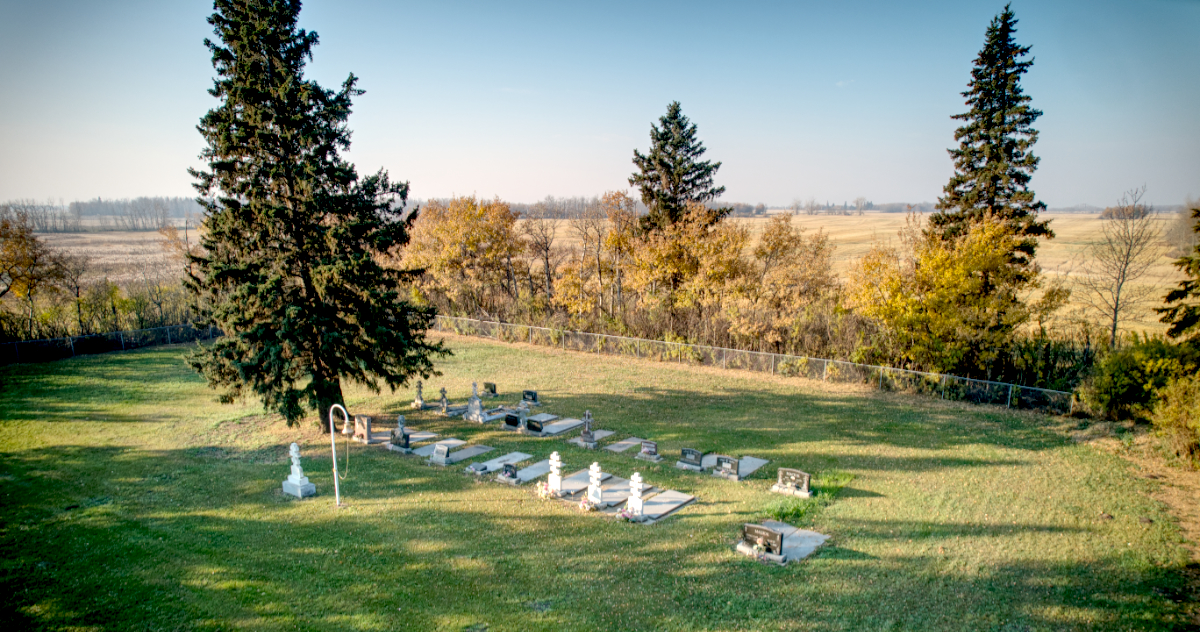

Play Memory Eternal Chant
Visit this Cemetery
GPS Co-ordinates: 53.890001, -112.677852
Cemetery Co-ordinates: 53.886559, -112.678935
Affiliation: Ukrainian Orthodox Church of Canada
St. John the Baptist Ukrainian Orthodox Church – Peno, AB
Holy Trinity Ukrainian Orthodox Church – Myrnam (UOC)
According to a report published on 7 October 1925 in Ukrains’kyi holos, the first Ukrainian Orthodox Divine Liturgy was celebrated in the Myrnam area on 6 September 1925 by Rev. I. Kusey. A Ukrainian Orthodox congregation was formally organized in Myrnam in 1930, when the town was enjoying a period of growth stimulated by the arrival of the railway three years earlier. However, because of the hardships brought on by the Great Depression, the congregation was unable to begin building a separate place of worship for more than a decade, during which time services were held in the New Myrnam School.
As the economy started to improve at the outset of the Second World War, the Orthodox faithful of Myrnam were able to increase the tempo of their activities and to take on the challenge of building a church. The congregation officially joined the ranks of the Ukrainian Greek Orthodox Church of Canada on 26 January 1941, when the necessary papers were filed with the Consistory in Winnipeg. Meanwhile, a fundraising drive had been initiated the previous year, with construction finally beginning on a sanctuary in 1943. Wasyl Dolinsky, Michael Kawich, and Philip and Dmytro Hucal were contracted to serve as the work crew on the project, while Wasyl Topolnitsky was engaged to do the wiring. Ready for use in 1944 (when Rev. L. Diachina celebrated the first liturgy), the rectangular wood frame structure with a full basement had a medium-sized dome over an entranceway tower that housed the belfry, and two smaller domes at the corners of the facade. The new edifice henceforth became the hub of Ukrainian Orthodox community life in Myrnam, which reached its peak of vitality over the next two decades.
Between 1941 and 1950, a total of 111 church services were held at Holy Trinity Church. During this decade, the congregation had approximately 150 active members, when families were counted in their entirety. In 1951, Rev. I. Shwetz – who had been the resident priest since the end of the war – reported a paid membership of forty for his Myrnam flock, a figure that remained constant for several years.
The iconostasis was painted in 1958 by the renowned artist, Wadym Dobrolige (1913-1973). A successful fundraising drive brought in $1,400 toward the cost of this project. That same year Rev. M. Kryschuk assumed pastoral duties in the Myrnam area, his first assignment after his ordination. The appointment of a brand-new priest helped to revitalize the local Orthodox community, which was then being slowly undermined by vigorous competition from other denominations. At the time, the congregation had 28 registered members, a figure that rose to 34 the following year (when twenty-four services were held at Holy Trinity), and grew to forty by 1962. However, as the sixties drew to a close the Holy Trinity congregation inevitably began shrinking in size due to the migration of many young people to the city, and the gradual passing of senior members.
A lighted cross was added to the exterior of the church in 1978, thanks to a donation by Mr. and Mrs. Zaparyniuk. In the 1980s several major and minor renovations were made to the sanctuary. The outside walls were re-stuccoed, the domes repaired and repainted, and cedar shingles were replaced by sheet metal roofing. The interior of the church and the basement hall were also repainted, while the church floor was refinished and the flooring in the basement was replaced.
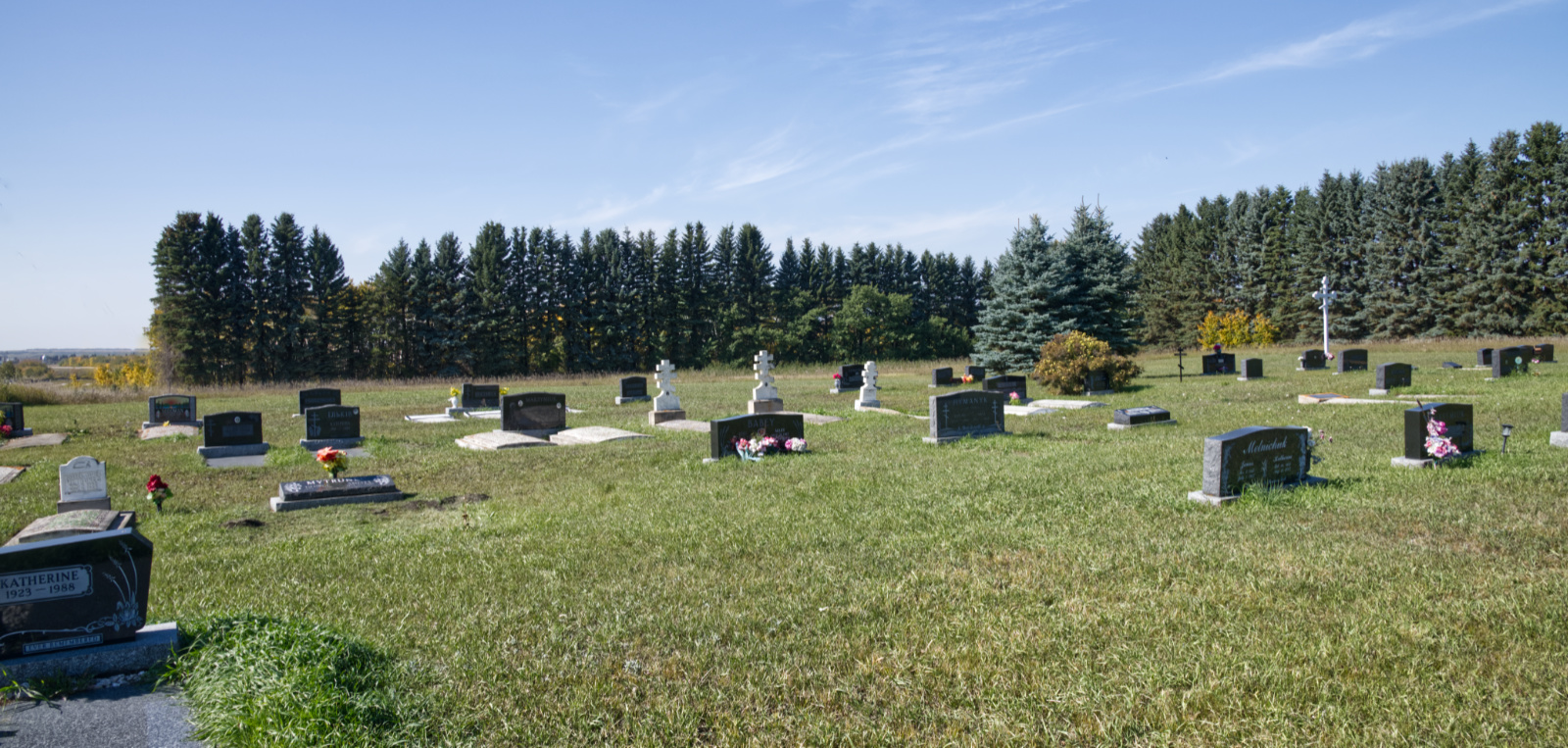
Play Memory Eternal Chant
GPS Co-ordinates: 53.662505, -111.225476
Cemetery Co-ordinates: 53.65818, -111.19265
Affiliation: Ukrainian Orthodox Church of Canada
Holy Trinity Ukrainian Orthodox Church – Myrnam, AB
Dormition of St. Mary Ukrainian Orthodox Church – Musidora (UOC)
The first attempts to organize a religious community in the Musidora area occurred between 1916 and 1920. Several meetings were held in an effort to establish a congregation, but activities remained informal with services occasionally being held at the homes of Safat Bikevich and Stefan Chanasyk. Apparently, local residents were divided as to their loyalties, with some preferring to be ministered to by the Basilian Fathers who were based in Mundare, others wanting to be served by clergy with the Russian Orthodox Mission. On the initiative of Reverend Kryzanowski, a Catholic church was finally built on the farm of John Kolisniak, though afterwards the majority of the Musidora faithful decided to sell this structure and instead pursue membership in the Ukrainian Greek Orthodox Church. Following this split, services were held at the residence of Wasyl Kolisniak or in the local National Hall, officiated by Reverend I. Kusey during occasional visits that he made in 1926.
In 1928-1929, a sanctuary was finally constructed by volunteers working under the supervision of a carpenter to provide a place of worship for the Orthodox faithful. Consecrated in the name of St. Mary, the church was initially served by Reverend Ivan Mayba. In early 1931 a request was made to the Consistory asking for the church to be incorporated under the charter of the UGOC, but a controversy soon erupted when some members insisted that the parish remain independent. The matter had serious implications, as there were still lingering fears in the community that the church could revert to Catholic control. Another concern was ownership of the cemetery that had been established in 1906 and blessed by Fr. Tymochko of the Ukrainian Catholic Church – which the congregation wanted to legally acquire as part of its landholdings. It took more than four decades to finally resolve the issue of incorporation, and while the cemetery continued to be shared for some time by local Orthodox and Catholic believers, title to it ultimately passed into the hands of the congregation of St. Mary’s.
From the mid-thirties to the outbreak of the Second World War there were problems getting clergy to provide pastoral care for the Musidora faithful. As the All Saints Greek Catholic church was built in nearby Morecambe around this time, the Consistory was informed that St. Mary’s could lose some of its members to the Ukrainian Catholics – no doubt to underscore the need to find a regular priest. Although, the situation seems to have stabilized by 1940, new tensions appear to have surfaced by the late 1940s, this time due to the proselytizing efforts of the Russian Orthodox Church. In 1948 a couple of Musidora members again submitted an official request to Winnipeg to have St. Mary’s congregation incorporated as part of the Ukrainian Greek Orthodox Church of Canada, probably to ensure their church’s allegiance to the Consistory. However, because the initiators of the petition also indicated that most of their fellow adherents were sympathetic to the Russian Orthodox Church, their submission was deemed legally unrepresentative of the will of the majority. Nevertheless, the congregation continued to be faithfully served throughout these difficult years by the UGOC, whose priests officiated at a dozen liturgies in the community in 1949.
In 1951, Musidora congregation was comprised of eighteen members, and in the following year fifteen Divine Liturgies were celebrated at St. Mary’s. Notwithstanding the fact that the Myrnam district constructed a manse around this time, 1952 proved to be somewhat unsettled year because of complications involving the assignment of clergy. On 20 July 1953, the St. Mary’s faithful hosted an evening prayer service with Metropolitan Ilarion, after which a reception was held at the National Hall, where the community was also addressed by the head of Consistory, Fr. Ie. Hrycyna.
The period between the mid-1950s to the early 1960s marked a high point in the history of Musidora church, which increased its membership to a peak of 28 families. Reflecting the optimism of the St. Mary’s congregation around this time, in 1959 the artist Wadym Dobrolige was commissioned by the congregation to produce original ikons for an iconostasis and to decorate the interior of the church.
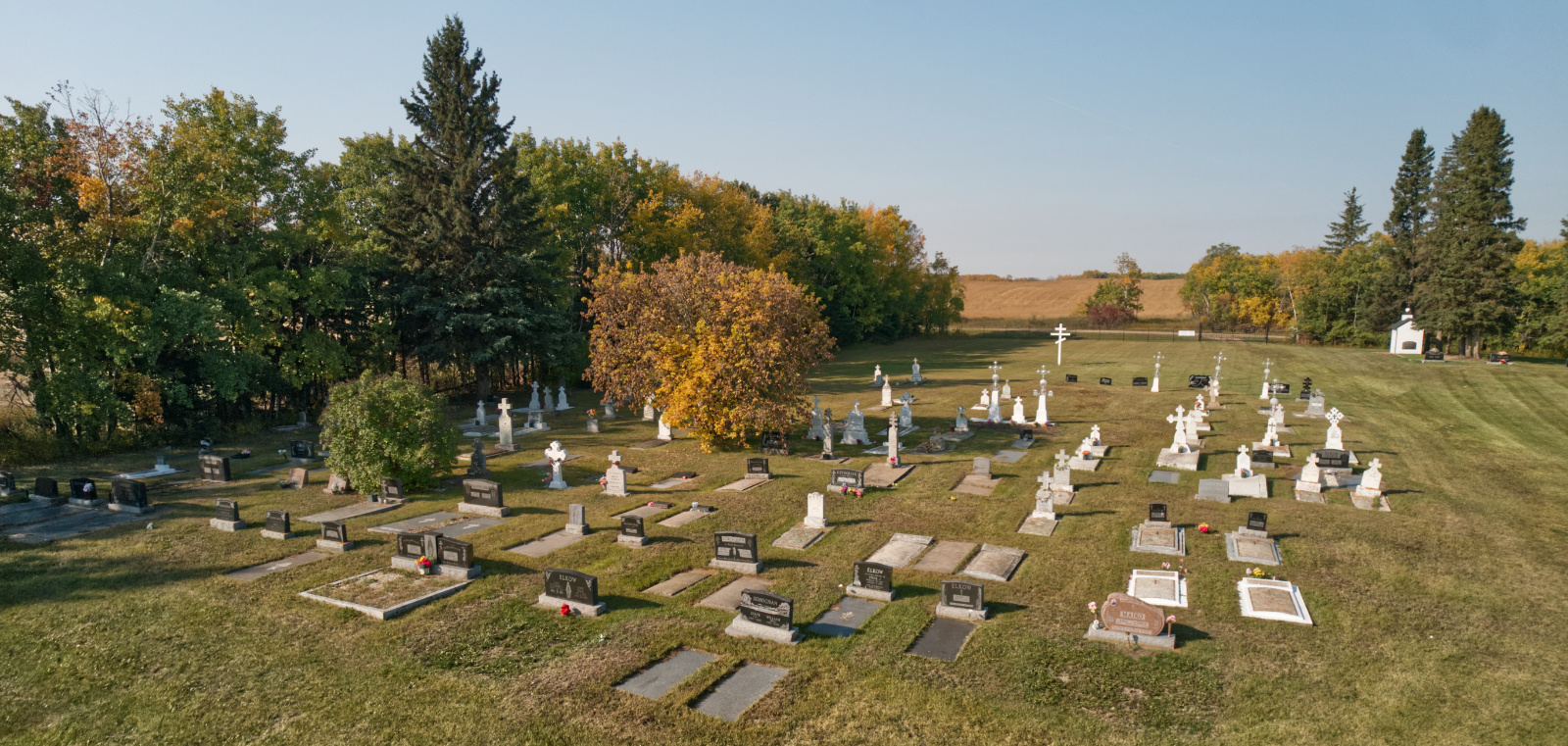
Play Memory Eternal Chant
GPS Co-ordinates: 53.688421, -111.582769
Cemetery Co-ordinates: 53.67943, -111.59861
Affiliation: Ukrainian Orthodox Church of Canada



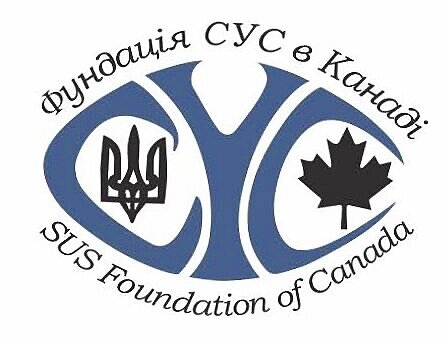 Financial support generously provided by:
Financial support generously provided by: 